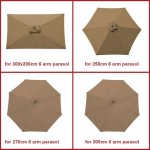How To Fix Patio Chair Seats: A Comprehensive Guide
Patio furniture, exposed to the elements, often suffers wear and tear, particularly in the seating area. Woven straps loosen, fabric fades and tears, and rigid materials crack and break. Addressing these issues promptly not only restores the aesthetic appeal of the outdoor space but also ensures the longevity and safety of the furniture. Several repair methods exist, each tailored to the specific material and damage present. This guide provides detailed instructions on various techniques for repairing common patio chair seat problems.
Replacing Woven Straps: A Step-by-Step Approach
Woven straps, commonly made of vinyl or nylon, are susceptible to stretching, cracking, and breaking due to prolonged exposure to sunlight and fluctuating temperatures. Replacing these straps involves removing the damaged material and installing new straps with proper tension. This process generally requires specific tools and materials tailored to the type of strapping used.
Materials Required:
- Replacement vinyl or nylon straps (matching original width and thickness)
- Rivets or screws (matching original type and size)
- Heat gun or hairdryer (for vinyl straps)
- Measuring tape
- Scissors or utility knife
- Screwdriver or rivet gun (depending on original fastening method)
- Pliers (optional, for removing old rivets)
Step 1: Removal of Damaged Straps
The initial step involves the careful removal of the existing damaged straps. Depending on the fastening method, this may involve unscrewing screws or drilling out rivets. If rivets are used, employ a drill bit slightly larger than the rivet's diameter and carefully drill through the center of the rivet head. Once the head is removed, the remaining rivet body can usually be punched out with a nail or small punch. If screws are used, simply unscrew them. Note the orientation and weaving pattern of the straps before complete removal; this will serve as a reference during reinstallation.
Step 2: Measuring and Cutting Replacement Straps
Accurate measurement is crucial for proper strap tension. Measure the distance between the attachment points on the chair frame. For vinyl straps, subtract approximately 10% of this measurement to account for stretching during installation. For nylon straps, the reduction may be less, typically around 5-7%, as nylon offers less elastic give. Cut the replacement straps to the calculated length using scissors or a utility knife. Precise cuts are essential to prevent fraying or uneven tension.
Step 3: Attaching the New Straps
Begin by attaching one end of the strap to the chair frame using the original fastening method (screws or rivets). If using rivets, ensure the rivet gun is properly loaded and the rivet is securely set. If using screws, tighten them sufficiently to hold the strap in place without stripping the threads. For vinyl straps, heating the strap slightly with a heat gun or hairdryer will make it more pliable and easier to stretch. Gently stretch the strap across the frame to the opposite attachment point. Align the strap and secure it with the remaining rivet or screw. Repeat this process for all remaining straps, maintaining a consistent weaving pattern as per the original design.
Step 4: Final Adjustments
Once all straps are installed, visually inspect the seat for proper tension and alignment. Adjust any straps that appear loose or uneven. For vinyl straps, a final application of heat can help the material conform to the frame and maintain its tension. Ensure all screws are tightened securely and all rivets are properly set. Trim any excess strap material if necessary, leaving a clean and professional finish.
Repairing Sagging or Torn Fabric Seats
Fabric patio chair seats, while comfortable, are vulnerable to tearing, fading, and sagging over time. Repairing or replacing fabric seats requires assessing the extent of the damage and choosing the appropriate repair method. Minor tears can often be mended, while more extensive damage may necessitate complete fabric replacement.
Materials Required (for Minor Repairs):
- Heavy-duty outdoor fabric patch (matching original fabric color and pattern)
- Needle and thread (heavy-duty, UV-resistant thread recommended)
- Scissors
- Seam ripper (optional, for removing loose threads)
- Fabric glue (optional, for temporary adhesion)
Materials Required (for Fabric Replacement):
- New outdoor fabric (sufficient to cover the entire seat)
- Measuring tape
- Scissors
- Seam ripper
- Sewing machine (or needle and thread for hand sewing)
- Pins
- Staple gun and staples (if applicable to the chair frame)
Step 1: Assessment of Damage
Carefully examine the fabric seat to determine the extent of the damage. Small tears or frayed edges can often be repaired with a patch or by reinforcing the existing fabric. Large tears, significant fading, or overall wear and tear may require complete fabric replacement. Inspect the underlying support structure (foam, webbing) for any damage. If the support structure is compromised, it should be repaired or replaced before addressing the fabric.
Step 2: Minor Tear Repair (Patching)
For small tears, a fabric patch can provide a durable and aesthetically pleasing repair. Clean the area around the tear with a damp cloth and allow it to dry completely. Trim any loose threads using scissors or a seam ripper. Cut a fabric patch slightly larger than the tear, ensuring it extends at least one inch beyond the edges of the damage. Position the patch over the tear, aligning the fabric pattern if possible. Secure the patch with fabric glue (optional) to prevent it from shifting during sewing. Using a needle and heavy-duty thread, sew the patch to the seat fabric, using a tight, even stitch. A zigzag stitch or a whipstitch provides extra strength. Trim any excess patch material after sewing.
Step 3: Fabric Replacement
Fabric replacement involves removing the old fabric, creating a new cover, and attaching it to the seat frame. Use a seam ripper to carefully remove the existing fabric cover, taking care not to damage the underlying support structure. This will serve as a pattern for the new cover. Lay the old fabric cover on top of the new outdoor fabric and trace its outline, adding a seam allowance of approximately one inch around the entire perimeter. Cut out the new fabric cover. Pin the fabric pieces together, right sides facing, and sew along the traced lines, leaving an opening for turning the fabric right side out. Turn the fabric right side out and press the seams with an iron. Stuff the seat cushion back into the new cover. If the chair frame utilizes staples, stretch the fabric tightly over the frame and secure it with staples, working from the center outwards to avoid wrinkles. If the cover is sewn onto the frame, hand stitch the opening closed, ensuring a tight and secure fit.
Addressing Cracked or Broken Rigid Seats (Plastic or Resin)
Rigid patio chair seats made of plastic or resin are prone to cracking or breaking, especially under heavy use or in extreme weather conditions. Repairing these seats typically involves using specialized adhesives and reinforcing materials to bridge the cracks and restore structural integrity. The success of the repair depends on the severity of the damage and the type of plastic or resin used.
Materials Required:
- Plastic or resin repair kit (containing adhesive, filler, and reinforcing mesh or tape)
- Sandpaper (various grits, from coarse to fine)
- Cleaning solvent (isopropyl alcohol)
- Putty knife or applicator
- Clamps (optional, for holding pieces together)
- Safety glasses and gloves
Step 1: Preparation of the Damaged Area
Thorough preparation is essential for a successful repair. Clean the cracked or broken area with a cleaning solvent (such as isopropyl alcohol) to remove any dirt, grease, or debris. Sand the area around the crack with coarse sandpaper to create a rough surface for the adhesive to bond to. This will also help to feather the edges of the crack and create a smoother transition between the damaged area and the surrounding material. If the crack is large or the pieces are separated, use clamps to hold the pieces together in their original position.
Step 2: Application of Adhesive and Filler
Follow the instructions provided with the plastic or resin repair kit. Typically, this involves mixing the adhesive and filler according to the manufacturer's recommendations. Apply the mixture to the crack, filling it completely and overlapping the surrounding area. Use a putty knife or applicator to smooth the surface and remove any excess material. For larger cracks or areas subject to significant stress, embed reinforcing mesh or tape into the adhesive while it is still wet. This will provide added strength and prevent the crack from reoccurring. Allow the adhesive to cure completely according to the manufacturer's instructions. This may take several hours or even overnight.
Step 3: Sanding and Finishing
Once the adhesive is fully cured, sand the repaired area with progressively finer grits of sandpaper to achieve a smooth and seamless finish. Start with medium-grit sandpaper to remove any major imperfections and then move to fine-grit sandpaper to blend the repair into the surrounding surface. Clean the area with a damp cloth to remove any sanding dust. If desired, paint the repaired area with a paint that is compatible with the plastic or resin to match the original color of the chair. Apply several thin coats of paint, allowing each coat to dry completely before applying the next.
Step 4: Reinforcement (Optional)
For severely damaged areas, consider adding additional reinforcement to the underside of the seat. This can be accomplished by applying a layer of fiberglass resin and fiberglass matting to the back of the repaired area. This will provide significant structural support and prevent the crack from spreading. Follow the manufacturer's instructions for mixing and applying the fiberglass resin. Allow the resin to cure completely before using the chair.

Replacing Repairing Dryrotted Fabric On Outdoor Furniture Hometalk

How To Save Yourself Money With Diy Patio Chair Repair

How To Save Yourself Money With Diy Patio Chair Repair

Dollar Patio Chair Seat Replacement Furniture Redo Wood Repair

How To Replace Two Piece Sling Chair Fabric Youtube

How To Repair Outdoor Furniture Scratches Green With Decor

How To Save Yourself Money With Diy Patio Chair Repair

Replacing Rush Seats Step By Tutorial A Stroll Thru Life

How To Replace Fabric On A Patio Sling Chair Youtube

How To Repair Outdoor Furniture Scratches Green With Decor








